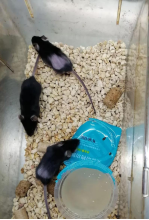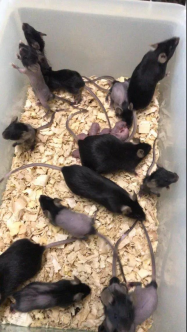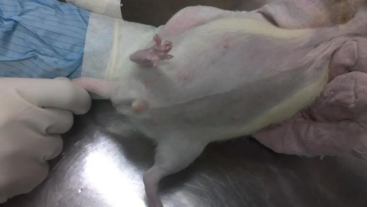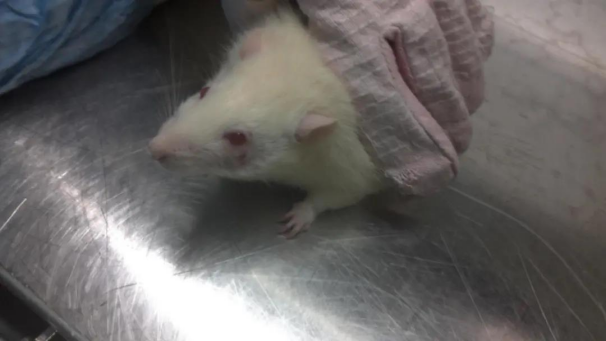


In our Animal Breeding series, we introduce new information about rodent breeding and health every week to provide education for aspiring animal care experts. The topic of today's article is over grooming and barbering, a common problem in mouse breeding, especially among C57BL-related strains.
Read on to explore why rodent groups barber themselves and each other, the ways this may be prevented, and some common questions and answers about this issue.
What is Rodent Barbering Behaviors of Rats and Mice?
Barbering is an abnormal grooming behavior of rodents that is typically associated with alopecia (hair loss, balding). This behavior involves excessive chewing of fur, which may be displayed by a mouse on itself or its cage mates. Barbering has been considered an expression of dominance if mice are nibbling and plucking the fur and/or whiskers of their cage mates. If barbering behaviors are not resolved, especially excessing whisker plucking, it may become a serious animal welfare issue. Unaddressed, barbering could result in Ulcerative Dermatitis (UD), which is the most common unplanned euthanisia performed in mice.
•Usually the skin area of alopecia is well demarcated and the skin is not damaged;
•Usually self-barbers do not have any hair loss, but may be groomed;
•For breeding pairs, males may have scabs on the face and thinning of the coat.
Risk factors to Barbering
Barbering was found to be related to a number of risk factors, detailed as follows:
•Environmental: such as excessive density, irritation by disinfectant;
•Nutritional: lack of essential amino acids and vitamins;
•Genetic: related to strain characteristics, C57BL/6 mice are more prone to grooming than ICR mice;
•Gender: Females are more prone to barbering than males, 1.5 times the frequency of males;
• Physiological factors: Grooming behavior increases in female mice during gestation.
Types of Barbering
•Barber mice, as they are known, remove the fur or whiskers of other mice. Usually only one mouse in a group cage is completely haired, while the other mice are groomed in a similar areas, sizes, and shapes;
•One or more mice may cull other mice's face, head, body, or whiskers;
•Sometimes the sides of the mouse's mouth are groomed. Not only are the whiskers plucked, but the coat on both sides of the mouth may also be plucked;
•Sometimes both the dominant mice in the cage exhibit grooming behavior.

Figure 1. Barber mouse and other mice. (Source: Cyagen)
The typical feature of female mouse barbering is that the coat of the pups that are about to be weaned is removed, and only a small amount of coat such as the head is retained, which is basically considered to be the behavior of female barbers.

Figure 2. Female barbers and other mice. (Source: Cyagen)
Self-grooming, also known as autogrooming, often occurs in breeding pairs of rats. Pregnant females pluck their hairs before giving birth, along the sides of the abdomen or the lower part of the legs, sometimes on one side of the body, and in large patches.

Figure 3. Pregnant/gestating females. (Source: Cyagen)
•It often occurs in the breeding pair of rats, and there are pregnant female rats in the same cage. In addition to the sparse coat on the face of the male rat, it is usually accompanied by scabs, etc.;
•Females are occasionally seen pulling the facial coat of males in breeding pairs of mice, but this rarely results in damage.

Figure 4. Loss of facial hair in male rats. (Source: Cyagen)
Differential Diagnosis
•The skin of animals undergoing normal barbering behavior is basically uninjured, and most have no pain or symptoms of distress. However, when the skin is mottled, scaly, and the animal is distressed, factors to consider include parasitic infections, dermatophytes, and specific hair loss.
•Hormone-induced alopecia is rare and manifests as bilaterally symmetrical alopecia, mostly in areas beyond the reach of the animal.
•Grooming is usually reversible. After removing the risk factors for physical hair loss, many mice regrow hair within a few weeks once excessive grooming is stopped;
•For breeding cages, especially females in late pregnancy. Be sure to put nesting material. Otherwise, the female rat will pluck her own hair or the male's hair instead.
•Littermates groom each other, causing hair loss on the whiskers, back, ears, and around the eyes. The skin of the exposed part of the grooming is normal, without scab or redness. After the mice are separated into cages, the hair will grow naturally in the later stage. Excessive grooming will cause ulcerative skin damage. In this case, it is recommended to wipe the wound with iodine 1-2 times a day, and it can be improved in about a week.
•Appropriately adding some environment-rich items to the cage for animals to play with will reduce the phenomenon of grooming, such as adding paper cups, nest materials, and toys. At the same time, it is also necessary to continuously observe the condition of the hair loss site. If there is an abnormality in the hair loss site, it should be considered that it may be caused by infection.




영업일 기준 1-2일 내에 답변해 드리겠습니다.